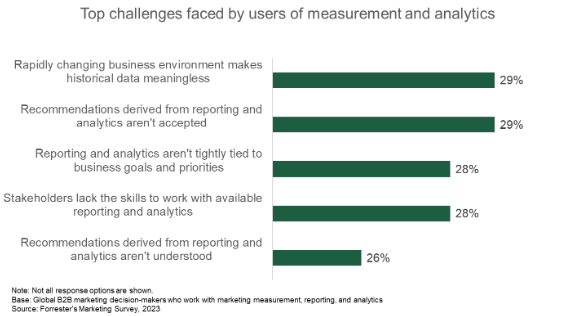A strong CMO dashboard provides marketing leaders with the visibility they need to monitor marketing’s performance. It sends up warning signs when remediation is needed. But to do those jobs, it must remain aligned with marketing’s plans and clearly reflect its objectives.
Many of my clients currently find themselves knee-deep in planning season, that time of year when objectives get set, tweaked, and reestablished. Now’s also the perfect time to revisit your CMO dashboard to ensure that it’s up to the task.
Let’s Face It: B2B Organizations Struggle With CMO Dashboards
One of the most common needs I hear from marketing, marketing analytics, and marketing operations leaders is the need to develop CMO dashboards capable of shedding light on marketing’s contribution. Forrester’s Marketing Survey, 2023, data backs this up: 30% of B2B marketing decision-makers reported that improving the use of analytics to measure marketing’s contribution and enhance decision-making ranks among the top actions that their marketing organization must take to support organizational priorities in the coming months.
Our research also tells us that the measurement and analytics challenges faced by B2B marketers are complex. Marketing stakeholders commonly lack the skills to work with analytics. Recommendations derived from analytics aren’t readily accepted. But the one measurement user challenge that stands out most to me is that users feel reporting and analytics aren’t tightly tied to business goals and priorities. This is where I see CMO dashboards falling short, although the reasons behind this shortcoming can take several forms:
- Featured metrics are too broad. Dashboards that only provide summarized business performance metrics, such as revenue growth or retention rates, lack clear tie-ins to the role that marketing plays in driving those numbers. By not connecting business-level goals to what marketing actually does, stakeholders lose the plot and don’t follow the story of how marketing helps. Marketing’s credibility as a contributor gets called into question.
- Selected metrics feel insignificant. CMO dashboards that provide a long list of marketing’s activities without a clear connection to what marketing is trying to accomplish are uninteresting. Presented as standalones, campaign performance, brand performance, and event performance read like a list of how marketing keeps itself busy but don’t present marketing as an essential contributor to the business strategy. Effective marketing metrics must make the connection between what marketing is doing and the business value that it’s attempting to create.
- Key metrics lack reference points. When reporting users see metrics describing how much marketing engagement is being created, but lack the ability to compare that engagement level to the volume of engagement that should be created, they can’t tell if performance is good or bad. And when users don’t know if performance is on track or not, they can’t decide whether remedial action is needed.

Sharpen Planning To Make Your CMO Dashboard Relevant
The above shortcomings are rooted in marketing plans that need to be taken just a little bit further. Forrester’s B2B Marketing Plan On A Page provides a useful tool for detailing the relationships between the objectives of the business, marketing’s goals, and the key actions that marketing will take to accomplish these goals. Planning season presents a great opportunity for leaders to lean harder into planning and create a foundation for great measurement by making these refinements to the existing process:
- Demand precision in marketing’s goal definition. A useful dashboard provides clarity in what marketing intends to accomplish. Sure, most businesses expect marketing to contribute to revenue growth, but clearly tying marketing’s efforts to business objectives requires greater specificity. Detail what types of revenue (net new, renewal, cross-sell, or upsell) marketing will affect and what types of buyers will be prioritized. A lack of precision might provide wiggle room in how marketing can contribute to the business’s objectives, but this flexibility comes at the expense of clear accountability. It opens space for plans to drift out of alignment with how the greater organization operates.
- Translate key actions into signs of progress. While marketing plans typically include the key actions that marketing will take to accomplish its goals, dashboards need to convey whether key actions are succeeding. Add on to the marketing planning process by pairing key actions with supporting metrics to serve as leading indicators of progress. For example, if marketing will establish a retention program aimed at engaging first-year clients, you’ll need options for how you’ll understand if it’s working. Select among metrics that convey how much engagement the programs are driving, how many accounts are engaged with the retention program, or even the portion of participating accounts with superior health scores. Secure agreement around the best options for managing ongoing efforts.
- Lock in what progress looks like. If recommendations derived from analytics are to be accepted, you need to preestablish a shared view of what good performance looks like and when alternative action is required. Once metrics are chosen, you’ll need to gain agreement on a comparable — a quantified target, goal, and/or reference point to be used for comparison. Without one, the process of making informed decisions about whether actions need to be taken or adjusted is unnecessarily complex. Don’t begin debate of what “good” looks like after results have already begun coming back; instead, set comparables at the outset.
For deeper recommendations on how to take advantage of planning season to sharpen your marketing measurement and make your CMO dashboard relevant, Forrester clients can check out the report, Turn B2B Marketing’s Goals Into Metrics For Steering The Business.








